Experimental Study on Inner Interface Mechanical Properties of the ESDCM Pile with Steel Core
Abstract
:1. Introduction
2. Experimental Methods
2.1. Fabrication of Test Models
2.1.1. Model Pile Preparation
2.1.2. Pressure Ring
2.2. Test Platform
2.2.1. Construction of Test Platform
2.2.2. Test Apparatus
2.3. Test Method
2.3.1. Confining Pressure Transfer Test
2.3.2. Steel-Pipe–Cement-Soil Interface Shear Test
3. Results and Discussion
3.1. Unconfined Compressive Strength Test
3.2. Confining Pressure Transfer Test
3.3. Shear Test at the Steel-Pipe–Cement-Soil Interface
4. Conclusions and Outlooks
- (1)
- In the confining pressure transfer test, the semi-rigid soil-cement column, as a transition layer, resists more than 95% of the lateral confining pressure well and substantially reduces the influence of confining pressure on the pile core, which ensures the stability of the vertical load-bearing performance of the pile core. In the shear test at the steel-pipe–cement-soil interface, the shear process can be divided into four stages: the small deformation stage of the steel pipe, which is the extra stage compared to the common concrete–cement-soil combination form; the compression stage of the whole pipe; the brittle failure stage; and the shear-slip stage.
- (2)
- With the low load, the steel pipe and cement-soil were tightly bonded and did not produce relative displacement. In the elastic compression stage, the soil-cement column is compressed simultaneously with the steel pipe core, and the shear stress and shear displacement remain basically linear until reaching the ultimate peak of 194 kPa, which corresponds to the displacement of 5.4 mm and 5.9 mm at the bottom and top of the pile, respectively. In the brittle failure stage, the relative displacement of steel pipe and the soil-cement column further increases, the inner interface shear stress gradually decreases, and steel pipe and soil-cement column gradually strip altogether, entering the shear slip stage. Shear stress with the relative displacement growth gradually remains stable.
- (3)
- The steel-pipe–soil-cement-column bonding performance is considered satisfactory. Most of the time, the pipe and the column maintain a state of collaboration. For the ESDCM pile with steel pipe core, the bond strength of the steel-pipe–cement-soil interface is roughly 0.052 times the strength of the cement-soil. The smooth steel pipe can work closely with the cement-soil even at a low bonding coefficient. Further optimization of the steel-pipe–cement-soil interface structure can be an important way to improve the load-bearing potential of the pile. Eventually, when the steel-pipe–cement-soil interface breaks down, multiple large cracks penetrate the soil-cement column body, the steel pipe and the soil-cement column separate, and brittle damage occurs throughout the pile.
- (4)
- The steel pipe core undertakes all the upper loads, and the loads are evenly distributed inside the steel pipe core during the downward transfer process, spreading to the surrounding area through the transition layer of cement-soil, but the final load that can be transferred to the deep part is minor in comparison, accounting for only about 7% of the top load of the pile.
Author Contributions
Funding
Data Availability Statement
Conflicts of Interest
References
- Gu, M.; Cai, X.; Fu, Q.; Li, H.; Wang, X.; Mao, B. Numerical Analysis of Passive Piles under Surcharge Load in Extensively Deep Soft Soil. Buildings 2022, 12, 1988. [Google Scholar] [CrossRef]
- Zhou, Q.; Zhang, H.; Fu, C.; Zhou, Y.; Dai, Z.; Li, Y.; Tu, C.; Luo, Y. The distribution and morphology of microplastics in coastal soils adjacent to the Bohai Sea and the Yellow Sea. Geoderma 2018, 322, 201–208. [Google Scholar] [CrossRef]
- Huang, Y.; Jiang, X. Field-observed phenomena of seismic liquefaction and subsidence during the 2008 Wenchuan earth-quake in China. Nat. Hazards 2010, 54, 839–850. [Google Scholar] [CrossRef]
- Ferreira, T.M.; Mendes, N.; Silva, R. Multiscale Seismic Vulnerability Assessment and Retrofit of Existing Masonry Buildings. Buildings 2019, 9, 91. [Google Scholar] [CrossRef]
- Coduto, D.P. Foundation Design; Pomona, California State Polytechnic University: San Luis Obispo, CA, USA, 2001. [Google Scholar]
- Day, R.W. Foundation Engineering Handbook: Design and Construction with the 2009 International Building Code; McGraw-Hill Education: New York, NY, USA, 2010. [Google Scholar]
- Shu, B.; Gong, H.; Chen, S.; Ren, Y.; Li, Y.; Yang, T.; Zeng, G.; Zhou, M.; Barbieri, D.M.; Li, Y. Case Study of Solid Waste Based Soft Soil Solidifying Materials Applied in Deep Mixing Pile. Buildings 2022, 12, 1193. [Google Scholar] [CrossRef]
- Voottipruex, P.; Bergado, D.; Suksawat, T.; Jamsawang, P.; Cheang, W. Behavior and Simulation of Deep Cement Mixing (DCM) and Stiffened Deep Cement Mixing (SDCM) Piles Under Full Scale Loading. Soils Found. 2011, 51, 307–320. [Google Scholar] [CrossRef]
- Zhang, C.; Liu, S.; Zhang, D.; Lai, F.; Lu, T.; Liu, Y. A modified equal-strain solution for consolidation behavior of composite foundation reinforced by precast concrete piles improved with cement-treated soil. Comput. Geotech. 2022, 150, 104905. [Google Scholar] [CrossRef]
- Zhou, J.-J.; Gong, X.-N. A field study on the behavior of static drill rooted nodular piles with caps under compression. J. Zhejiang Univ. A 2015, 16, 951–963. [Google Scholar] [CrossRef]
- Ren, L.; Kong, G. Analysis on bearing capacity calculation and adjustment factor of JPP pile. In Proceedings of the 2011 International Conference on Electric Technology and Civil Engineering (ICETCE), Lushan, China, 22–24 April 2011. [Google Scholar]
- Wang, C.; Xu, Y.; Dong, P. Plate Load Tests of Composite Foundation Reinforced by Concrete-Cored DCM Pile. Geotech. Geol. Eng. 2013, 32, 85–96. [Google Scholar] [CrossRef]
- Zhou, J.-J.; Gong, X.-N.; Wang, K.-H.; Zhang, R.-H.; Yan, T.-L. A Model Test on the Behavior of a Static Drill Rooted Nodular Pile Under Compression. Mar. Georesources Geotechnol. 2015, 34, 293–301. [Google Scholar] [CrossRef]
- Zhou, M.; Li, Z.; Han, Y.; Ni, P.; Wang, Y. Experimental Study on the Vertical Bearing Capacity of Stiffened Deep Cement Mixing Piles. Int. J. Géoméch. 2022, 22, 04022043. [Google Scholar] [CrossRef]
- Han, Y.; Cheng, J.; Zhou, M.; Ni, P.; Wang, Y. Experimental Study of Compaction and Expansion Effects Caused by Penetration of Core Pile During Con-struction of SDCM Pile. Int. J. Geomech. 2022, 22, 04022041. [Google Scholar] [CrossRef]
- Hossain, M.A.; Yin, J.-H. Dilatancy and strength of an unsaturated soil-cement interface in direct shear tests. Int. J. Geomech. 2015, 15, 04014081. [Google Scholar] [CrossRef]
- Jamsawang, P.; Bergado, D.; Bandari, A.; Voottipruex, P. Investigation and simulation of behavior of stiffened deep cement mixing (SDCM) piles. Int. J. Geotech. Eng. 2008, 2, 229–246. [Google Scholar] [CrossRef]
- Li, Y.; Sun, L.; Li, X.; Huang, M. Experimental study on the shear mechanical properties of the cemented soil–concrete interface. Eur. J. Environ. Civ. Eng. 2021, 26, 4725–4739. [Google Scholar] [CrossRef]
- Dong, P.; Qin, R.; Chen, Z. Bearing capacity and settlement of concrete-cored DCM pile in soft ground. Geotech. Geol. Eng. 2004, 22, 105–119. [Google Scholar] [CrossRef]
- Wu, M.; Zhao, X. Bearing Behaviors of Stiffened Deep Cement Mixed Pile. Trans. Tianjin Univ. 2006, 12, 209–214. [Google Scholar]
- Zhou, J.; Yu, J.; Gong, X.; El Naggar, M.H.; Zhang, R. The effect of cemented soil strength on the frictional capacity of precast concrete pile–cemented soil interface. Acta Geotech. 2020, 15, 3271–3282. [Google Scholar] [CrossRef]
- Liu, H.; Zhu, M.; Li, X.; Dai, G.; Yin, Q.; Liu, J.; Ling, C. Experimental Study on Shear Behavior of Interface between Different Soil Materials and Concrete under Varia-ble Normal Stress. Appl. Sci. 2022, 12, 11213. [Google Scholar] [CrossRef]
- Alanazi, M.J.; Qinghua, Y.; Al-Bukhaiti, K. Performance Study of Buried Pipelines under Static Loads. Civ. Eng. J. 2022, 8, 1–23. [Google Scholar] [CrossRef]
- Zhou, J.-J.; Wang, K.-H.; Gong, X.-N.; Zhang, R.-H. Bearing capacity and load transfer mechanism of a static drill rooted nodular pile in soft soil areas. J. Zhejiang Univ. A 2013, 14, 705–719. [Google Scholar] [CrossRef] [Green Version]
- Tanchaisawat, T.; Bergado, D.; Voottipruex, P. Numerical simulation and sensitivity analyses of full-scale test embankment with reinforced lightweight geomaterials on soft Bangkok clay. Geotext. Geomembr. 2008, 26, 498–511. [Google Scholar] [CrossRef]
- Voottipruex, P.; Suksawat, T.; Bergado, D.; Jamsawang, P. Numerical simulations and parametric study of SDCM and DCM piles under full scale axial and lateral loads. Comput. Geotech. 2011, 38, 318–329. [Google Scholar] [CrossRef]
- Zhu, S.; Chen, C.; Cai, H.; Mao, F. Analytical modeling for the load-transfer behavior of stiffened deep cement mixing (SDCM) pile with rigid cap in layer soils. Comput. Geotech. 2022, 144, 104618. [Google Scholar] [CrossRef]
- Wonglert, A.; Jongpradist, P. Impact of reinforced core on performance and failure behavior of stiffened deep cement mixing piles. Comput. Geotech. 2015, 69, 93–104. [Google Scholar] [CrossRef]
- Zhang, S.; Fan, Y.; Shah, S.P. Study on Deformation Characteristics and Damage Model of NMK Concrete under Cold Environment. Buildings 2022, 12, 1431. [Google Scholar] [CrossRef]
- Brunesi, E.; Nascimbene, R.; Bolognini, D.; Bellotti, D. Experimental investigation of the cyclic response of reinforced precast concrete framed structures. PCI J. 2015, 60, 57–79. [Google Scholar] [CrossRef]
- Hemamathi, L.; Jaya, K.P. Behaviour of Precast Column Foundation Connection under Reverse Cyclic Loading. Adv. Civ. Eng. 2021, 2021, 6677007. [Google Scholar] [CrossRef]
- Shrestha, K.C.; Aoki, T.; Miyamoto, M.; Wangmo, P. Pema In-Plane Shear Resistance between the Rammed Earth Blocks with Simple Interventions: Experimentation and Finite Element Study. Buildings 2020, 10, 57. [Google Scholar] [CrossRef]
- Jayathilakage, R.; Rajeev, P.; Sanjayan, J. Rheometry for Concrete 3D Printing: A Review and an Experimental Compari-son. Buildings 2022, 12, 1190. [Google Scholar] [CrossRef]
- Hanna, J.; Baker, I. Effects of confining pressure on flaw formation during the consolidation of ductile powders by angular extrusion. Mater. Sci. Eng. A 2011, 536, 24–32. [Google Scholar] [CrossRef]
- Gao, Q.; Ren, C.; Zhang, J.; Ren, Z.; Liu, C.; Wang, S.; Liu, J.; Hu, Q.; Zhang, R. Development and Application of Shear Test Device for Pile-Reinforcement-Soil Interface. Available online: https://papers.ssrn.com/sol3/papers.cfm?abstract_id=4274180 (accessed on 10 November 2022).
- Chalioris, C.E.; Thermou, G.E.; Pantazopoulou, S.J. Behaviour of rehabilitated RC beams with self-compacting concrete jacketing–Analytical model and test results. Constr. Build. Mater. 2014, 55, 257–273. [Google Scholar] [CrossRef]
- Zhou, J.-J.; Gong, X.-N.; Wang, K.-H.; Zhang, R.-H.; Yan, J.-J. Testing and modeling the behavior of pre-bored grouting planted piles under compression and tension. Acta Geotech. 2017, 12, 1061–1075. [Google Scholar] [CrossRef]
- Zheng, G.; Yang, X.; Zhou, H.; Chai, J. Numerical modeling of progressive failure of rigid piles under embankment load. Can. Geotech. J. 2019, 56, 23–34. [Google Scholar] [CrossRef]
- Shi, X.; Nguyen, T.A.; Suo, Z.; Liu, Y.; Avci, R. Effect of nanoparticles on the anticorrosion and mechanical properties of epoxy coating. Surf. Coat. Technol. 2009, 204, 237–245. [Google Scholar] [CrossRef]
- Al-Saleh, M.H.; Sundararaj, U. Review of the mechanical properties of carbon nanofiber/polymer composites. Compos. Part A: Appl. Sci. Manuf. 2011, 42, 2126–2142. [Google Scholar] [CrossRef]
- Ministry of Housing and Urban-Rural Development, PRC. Specification for Mix Proportion Design of Cement Soil; JGJ/T233-2011; China Architecture & Building Press: Beijing, China, 2011. [Google Scholar]
- Zhou, Z.; Xu, F.; Lei, J.; Bai, Y.; Chen, C.; Xu, T.; Zhang, Z.; Zhu, L.; Liu, T. Experimental study of the influence of different hole-forming methods on the bearing characteristics of post-grouting pile in Loess Areas. Transp. Geotech. 2021, 27, 100423. [Google Scholar] [CrossRef]
- Rollins, K.M.; Sparks, A.E.; Peterson, K.T. Lateral Load Capacity and Passive Resistance of Full-Scale Pile Group and Cap. Transp. Res. Rec. J. Transp. Res. Board 2000, 1736, 24–32. [Google Scholar] [CrossRef]
- Faizal, M.; Bouazza, A.; Singh, R.M. Heat transfer enhancement of geothermal energy piles. Renew. Sustain. Energy Rev. 2016, 57, 16–33. [Google Scholar] [CrossRef]
- Tanchaisawat, T.; Suriyavanagul, P.; Jamsawang, P. Stiffened deep cement mixing (SDCM) pile. In Excellence in Concrete Construction through Innovation; CRC Press: London, UK, 2008; pp. 55–64. [Google Scholar]
- Jamsawang, P.; Bergado, D.; Voottipruex, P. Field behaviour of stiffened deep cement mixing piles. Proc. Inst. Civ. Eng.-Ground Improv. 2011, 164, 33–49. [Google Scholar] [CrossRef]
- Golewski, G.L. The Specificity of Shaping and Execution of Monolithic Pocket Foundations (PF) in Hall Buildings. Buildings 2022, 12, 192. [Google Scholar] [CrossRef]
- Behnia, A.; Chai, H.K.; GhasemiGol, M.; Sepehrinezhad, A.; Mousa, A.A. Advanced damage detection technique by integration of unsupervised clustering into acoustic emission. Eng. Fract. Mech. 2018, 210, 212–227. [Google Scholar] [CrossRef]
- Ma, T.; Zhu, Y.; Yang, X.; Ling, Y. Bearing Characteristics of Composite Pile Group Foundations with Long and Short Piles under Lateral Loading in Loess Areas. Math. Probl. Eng. 2018, 2018, 8145356. [Google Scholar] [CrossRef]
- Hambli, R. Comparison between Lemaitre and Gurson damage models in crack growth simulation during blanking process. Int. J. Mech. Sci. 2001, 43, 2769–2790. [Google Scholar] [CrossRef]
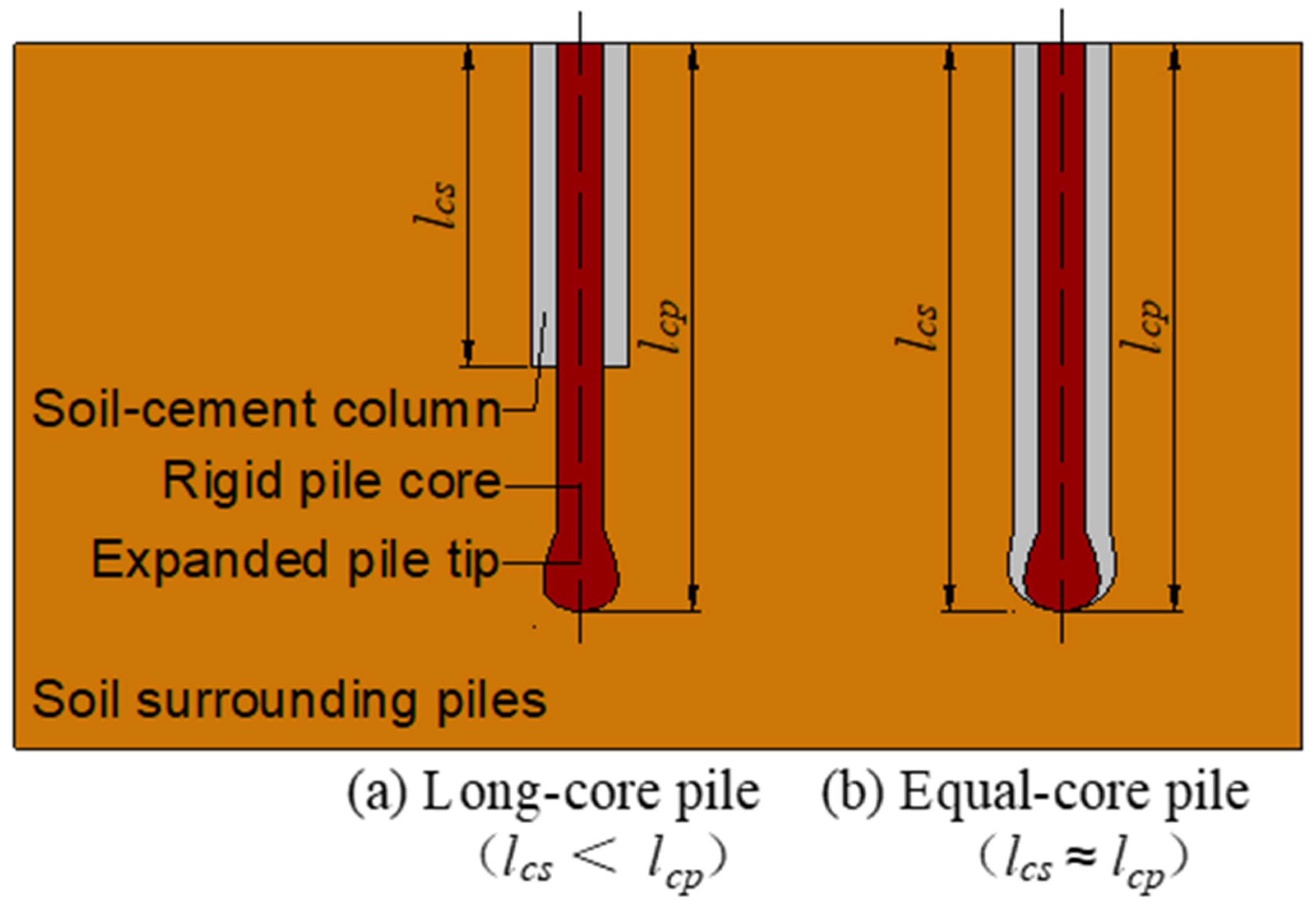
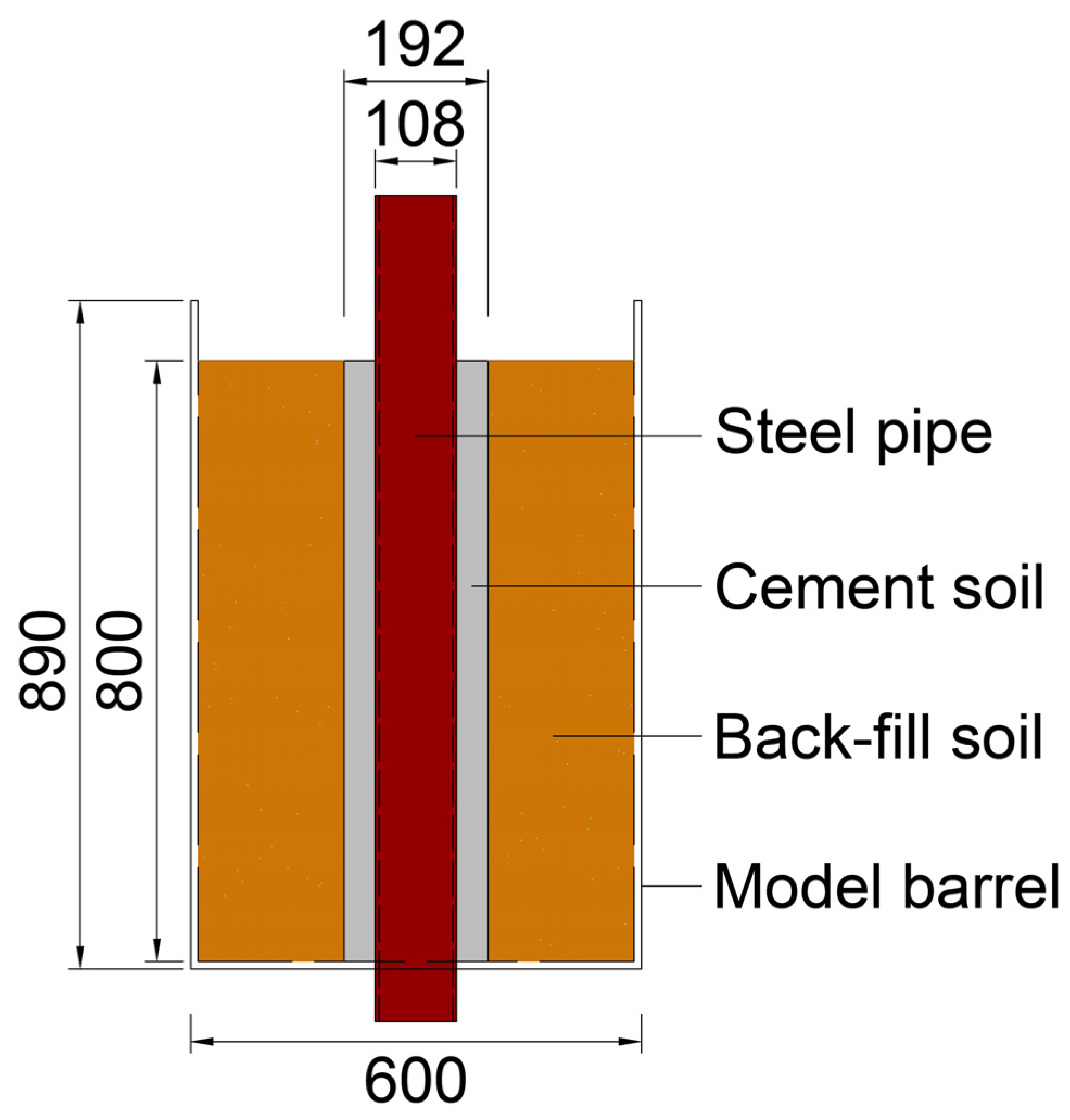
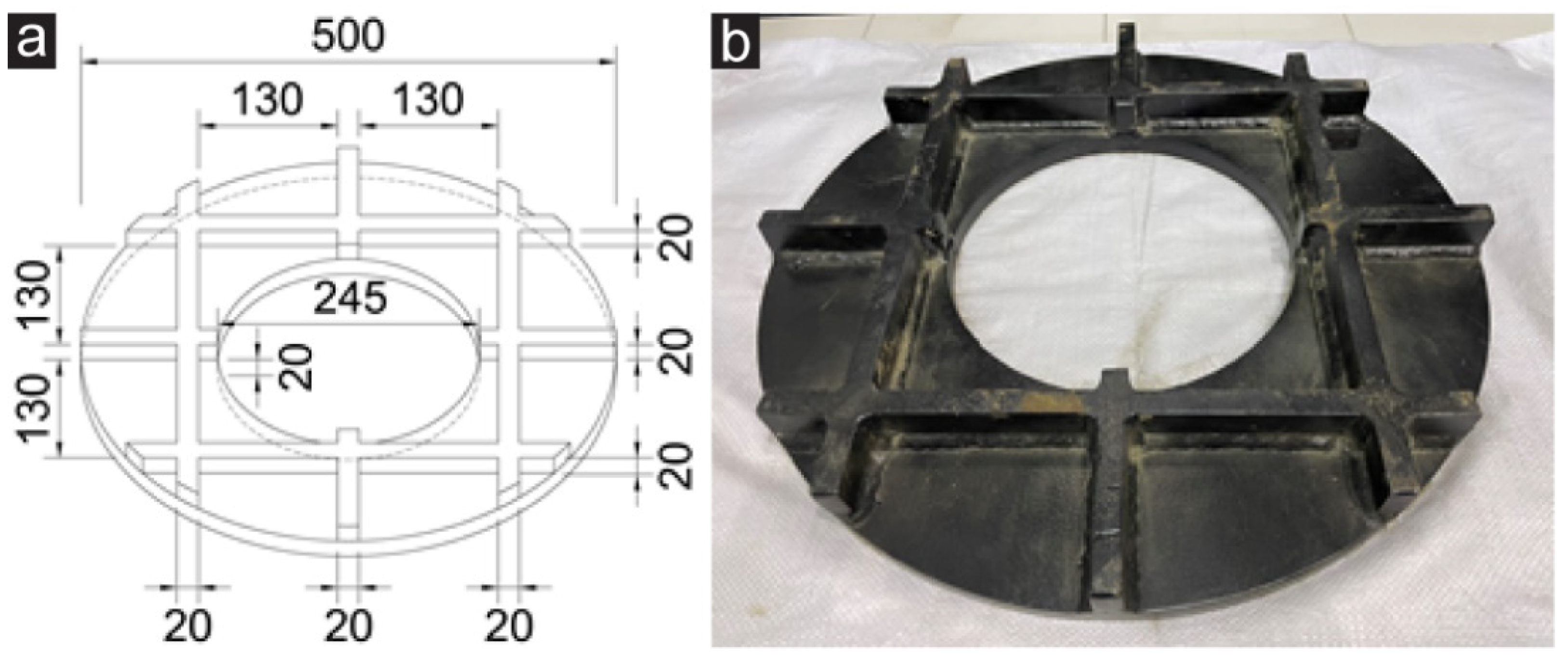
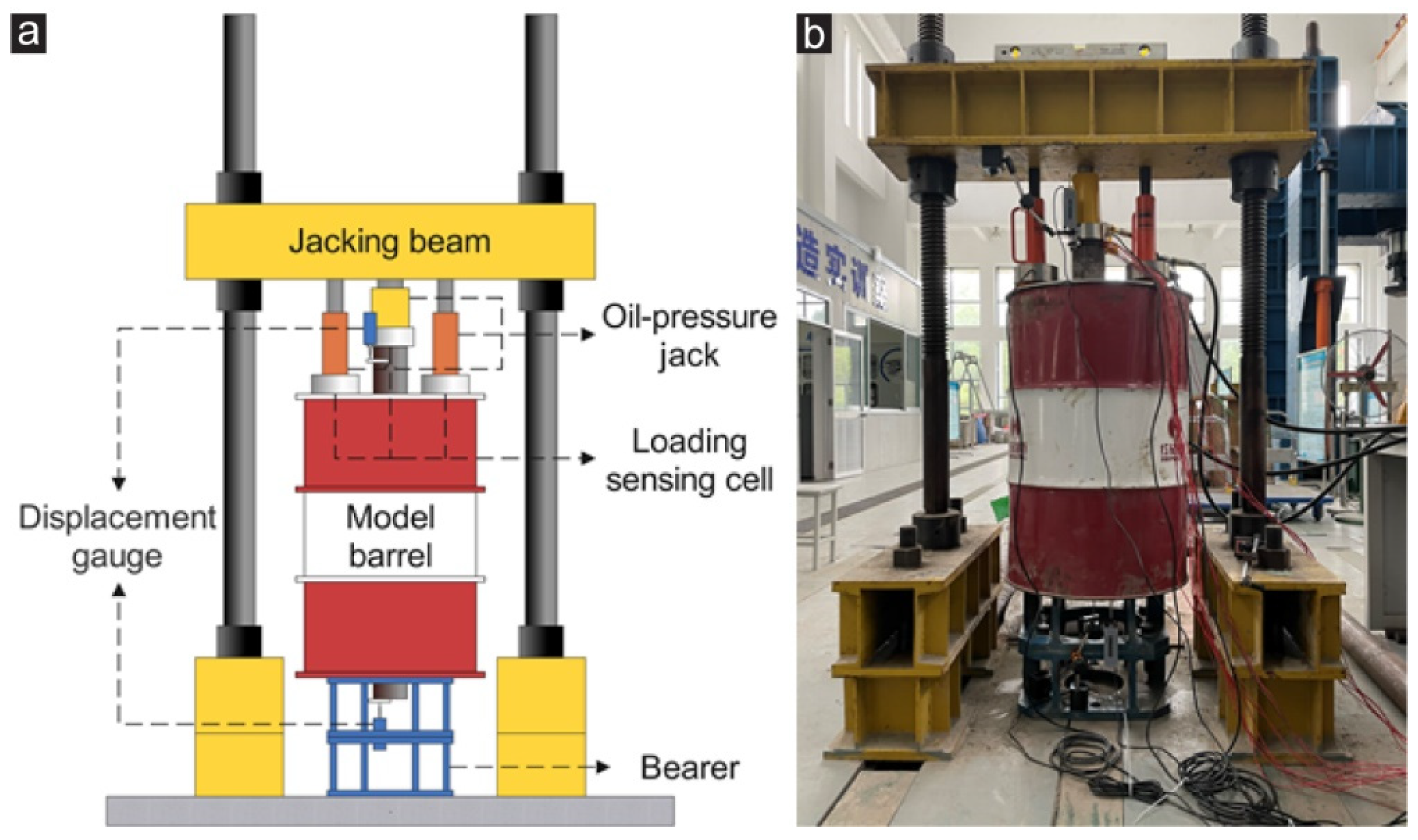

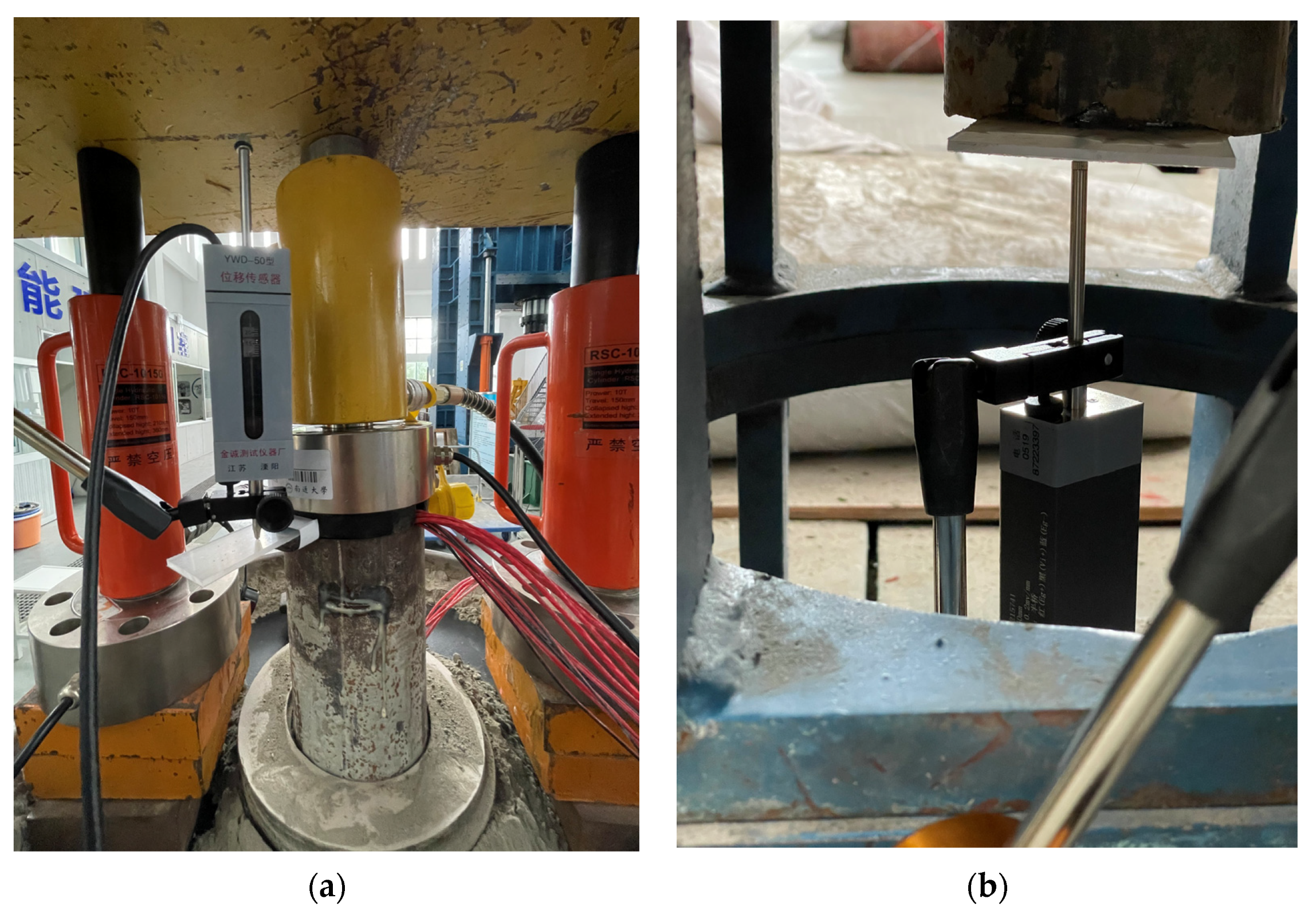
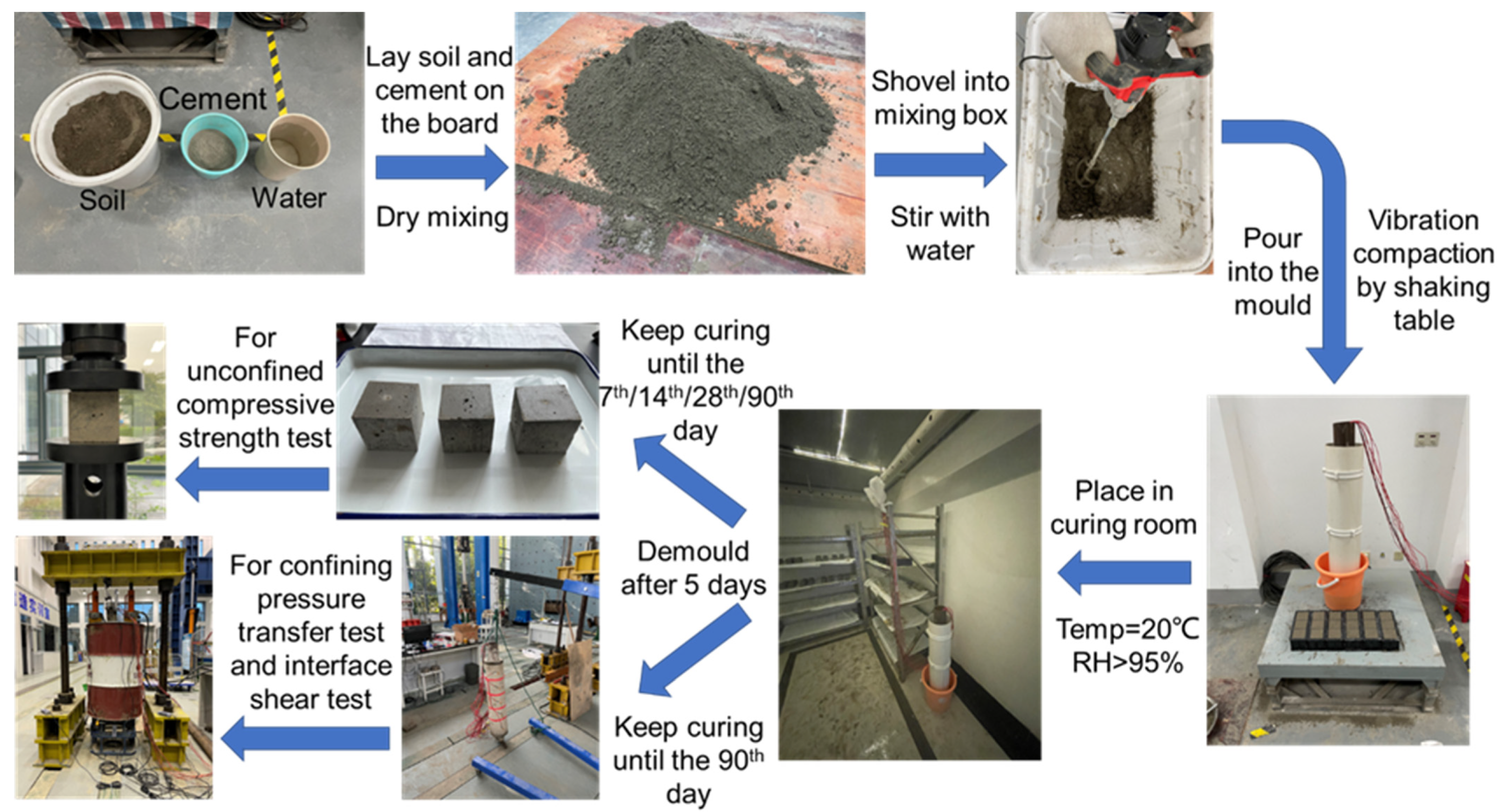
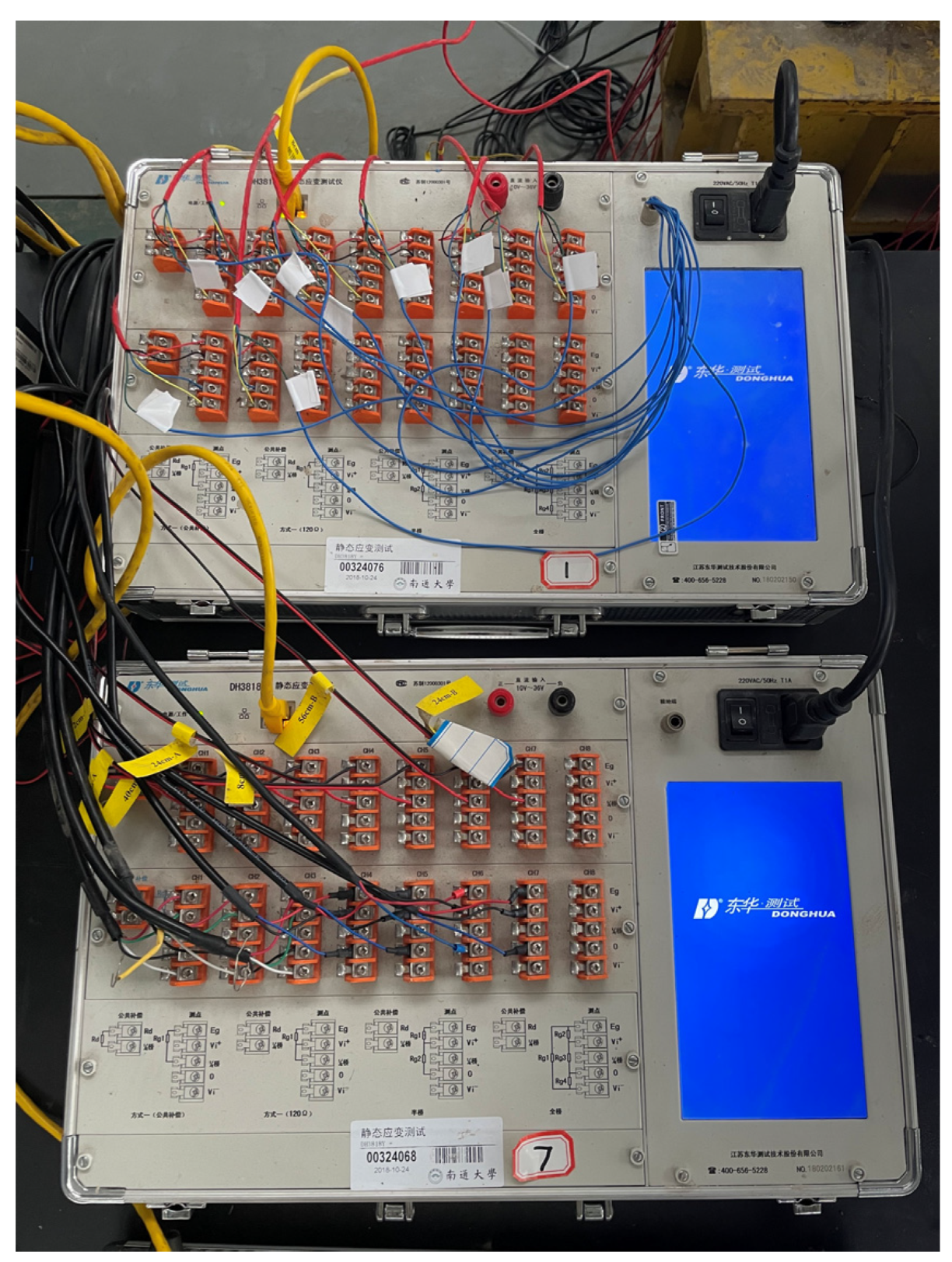

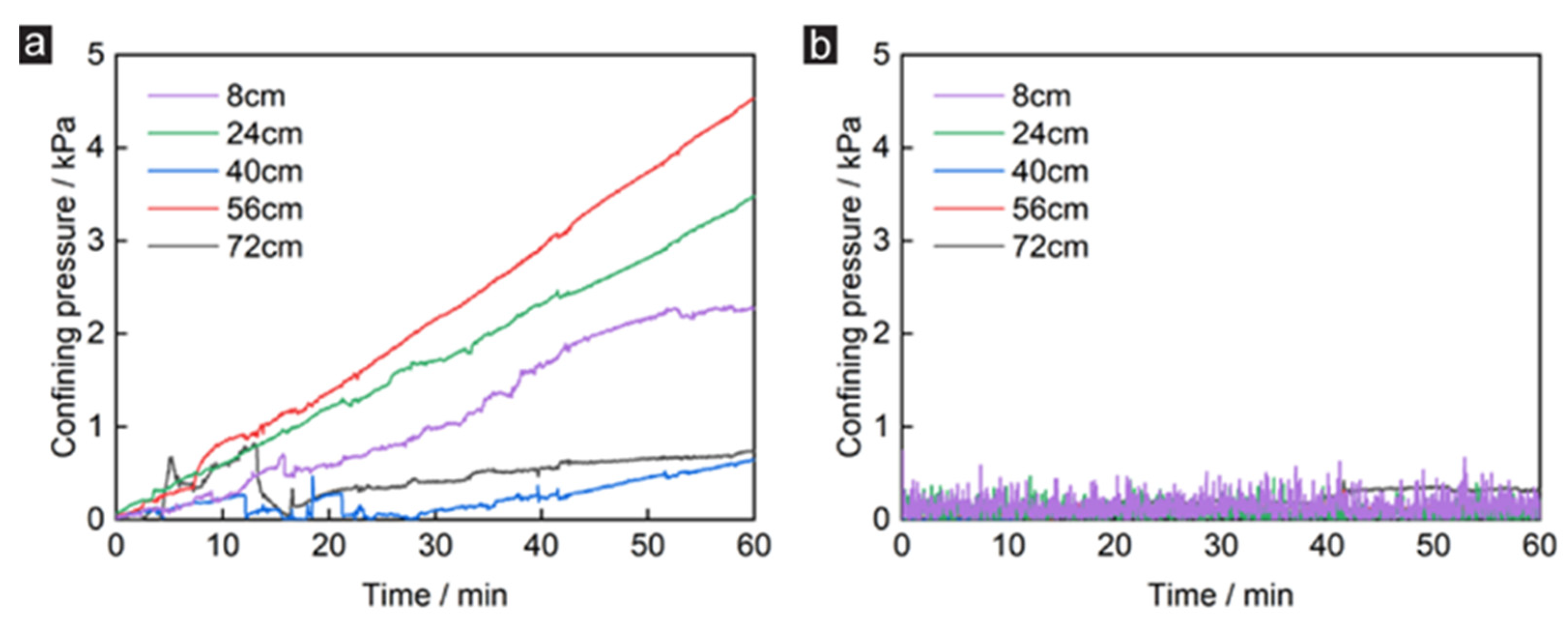


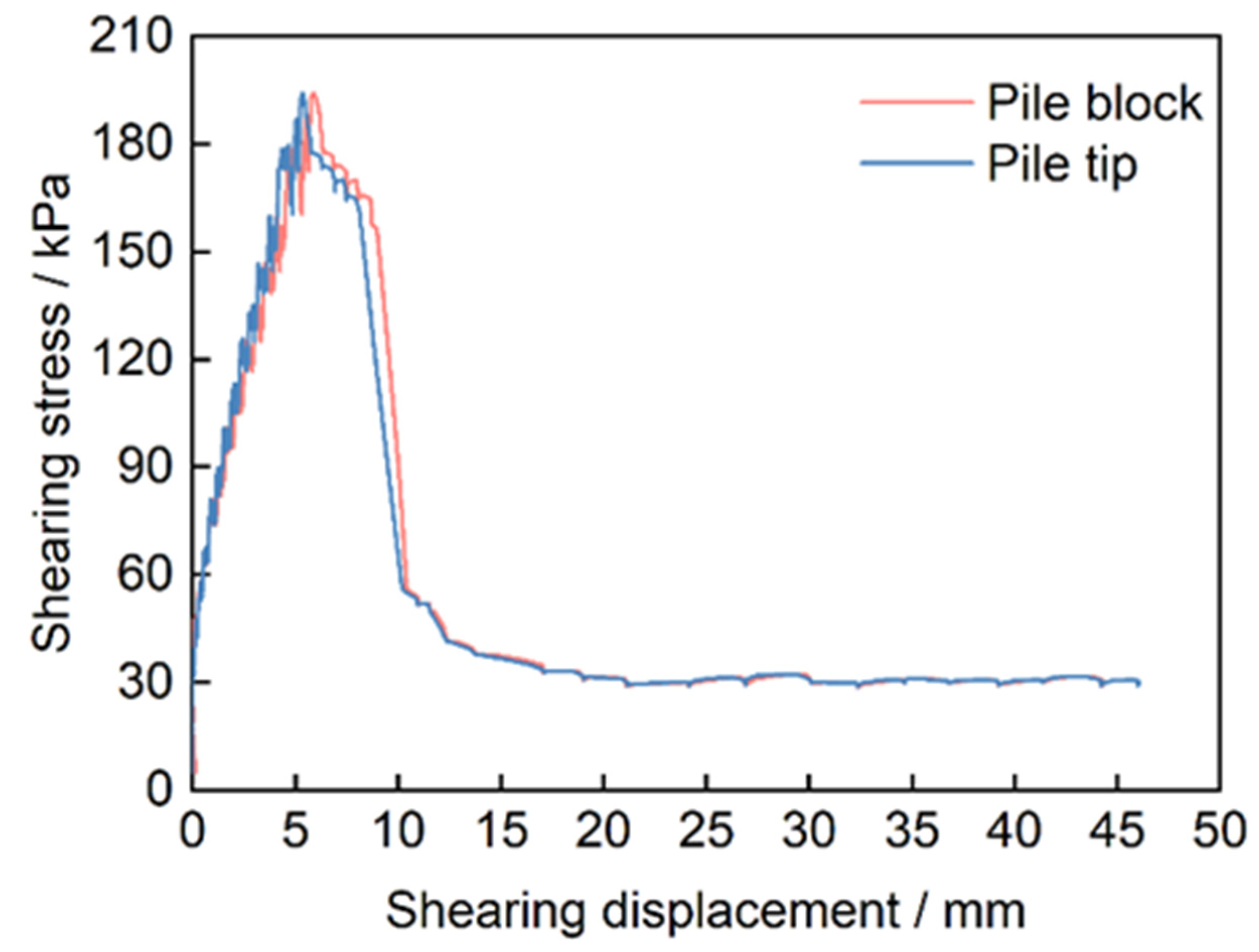
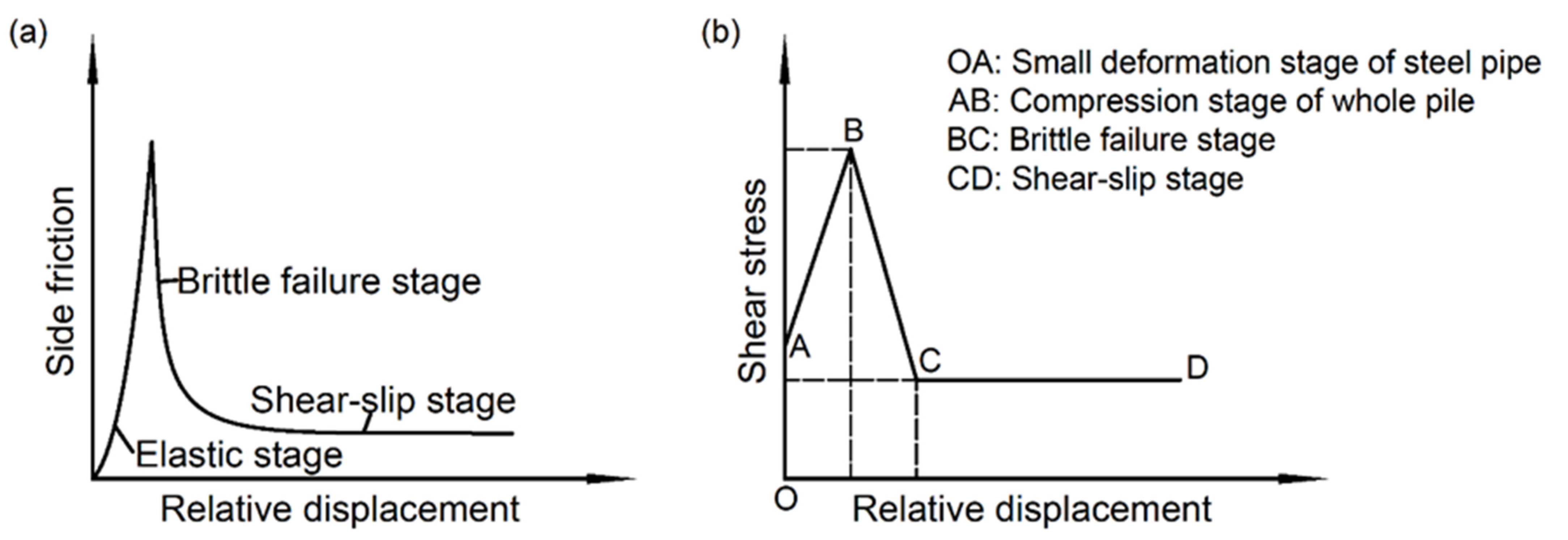
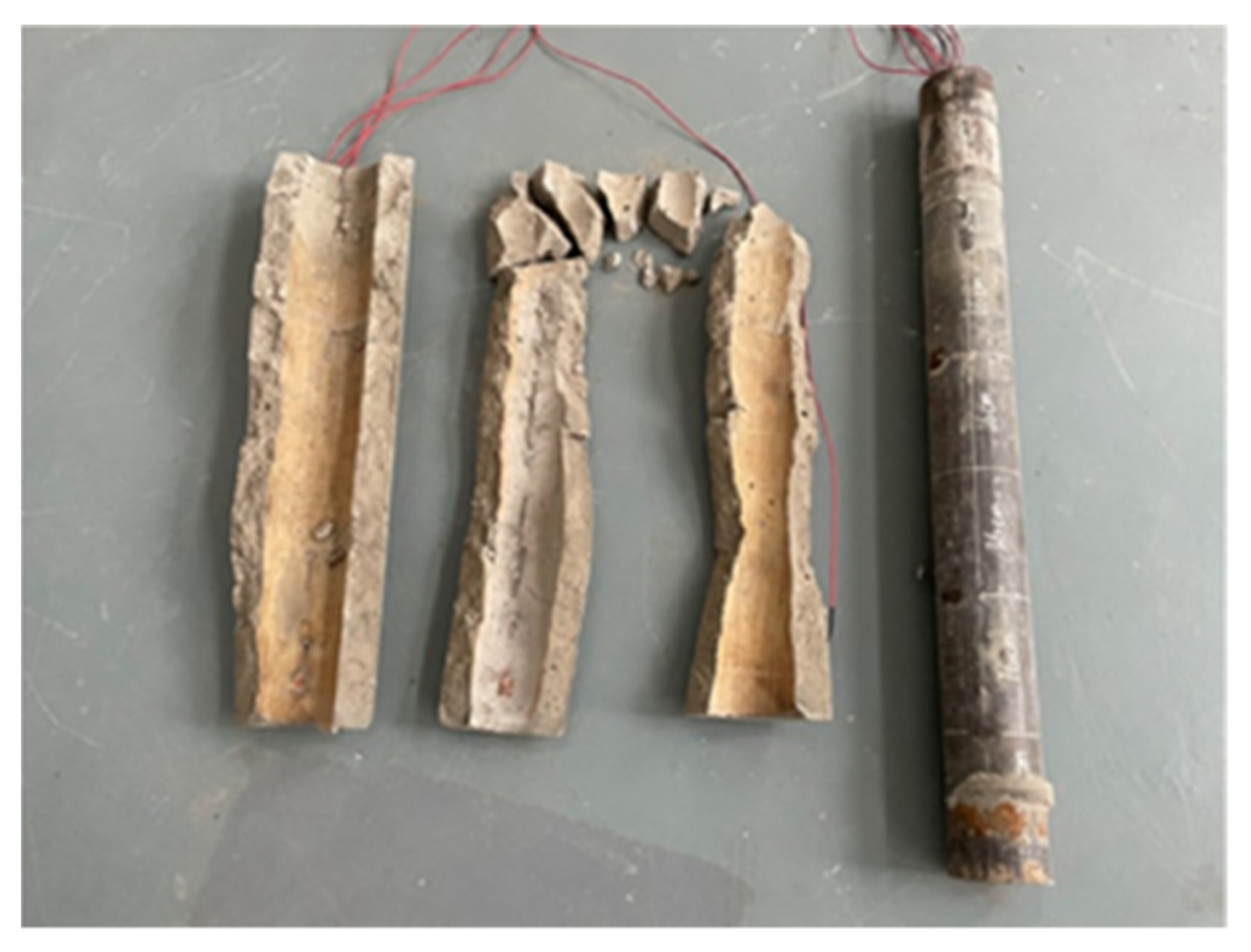

| Natural Water Content w (%) | Wet Density ρ (g/cm3) | Dry Density ρd (g/cm3) | Void Ration e | Liquid Limit Wl (%) | Plastic Limit Wp (%) | Cohesive Force C (kPa) | Friction Angle φ (°) |
|---|---|---|---|---|---|---|---|
| 31.4 | 1.85 | 1.41 | 0.918 | 32.4 | 22.6 | 16.7 | 18.8 |
| Age/D | Identifier | Test Strength/MPa | Average Strength/MPa | Standard Deviation | Ratio to the 90th Day Strength |
|---|---|---|---|---|---|
| 7 | #1 | 2.391 | 2.341 | 0.130 | 62.3% |
| #2 | 2.193 | ||||
| #3 | 2.438 | ||||
| 14 | #1 | 2.820 | 2.849 | 0.028 | 75.9% |
| #2 | 2.876 | ||||
| #3 | 2.850 | ||||
| 28 | #1 | 3.535 | 3.403 | 0.118 | 90.7% |
| #2 | 3.365 | ||||
| #3 | 3.308 | ||||
| 90 | #1 | 3.964 | 3.753 | 0.183 | 100% |
| #2 | 3.657 | ||||
| #3 | 3.638 |
Disclaimer/Publisher’s Note: The statements, opinions and data contained in all publications are solely those of the individual author(s) and contributor(s) and not of MDPI and/or the editor(s). MDPI and/or the editor(s) disclaim responsibility for any injury to people or property resulting from any ideas, methods, instructions or products referred to in the content. |
© 2023 by the authors. Licensee MDPI, Basel, Switzerland. This article is an open access article distributed under the terms and conditions of the Creative Commons Attribution (CC BY) license (https://creativecommons.org/licenses/by/4.0/).
Share and Cite
Bao, H.; Peng, J.; Cheng, Z.; Hong, J.; Gao, Y. Experimental Study on Inner Interface Mechanical Properties of the ESDCM Pile with Steel Core. Buildings 2023, 13, 486. https://doi.org/10.3390/buildings13020486
Bao H, Peng J, Cheng Z, Hong J, Gao Y. Experimental Study on Inner Interface Mechanical Properties of the ESDCM Pile with Steel Core. Buildings. 2023; 13(2):486. https://doi.org/10.3390/buildings13020486
Chicago/Turabian StyleBao, Hua, Jie Peng, Zhangjianing Cheng, Junqing Hong, and Yuan Gao. 2023. "Experimental Study on Inner Interface Mechanical Properties of the ESDCM Pile with Steel Core" Buildings 13, no. 2: 486. https://doi.org/10.3390/buildings13020486






